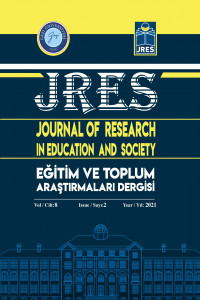Grup Piyano Eğitiminin Öğrenci Görüşleri Çerçevesinde Değerlendirilmesi
Bu araştırmanın amacı, grup piyano eğitiminden elde edilen kişisel kazanımları, piyano becerilerini ve sosyal/kültürel kazanımları öğrenci görüşlerine dayalı olarak belirlemek ve bazı değişkenlere göre istatistiksel olarak anlamlı farklılaşmaların olup olmadığını incelemektir. Araştırma, tarama modeline uygun betimsel niteliktedir. Araştırmanın çalışma grubu, Mehmet Akif Ersoy Üniversitesi grup piyano laboratuvarı ile Akdeniz Üniversitesi grup piyano laboratuvarında öğrenim gören 71 öğrenciden oluşmaktadır. Araştırmanın verileri, araştırmacı tarafından alan uzmanlarının görüşleri ve literatür taraması yapılarak oluşturulan yapılandırılmış görüşme formu ile toplanmıştır. Verilerin analizi için yüzde, frekans, ortalama ve standart sapma hesaplanmış, gruplar arası farkın belirlenmesi için anova ve t testinden yararlanılmıştır. Araştırma sonuçlarına göre, öğrencilerin grup piyano eğitiminden kazandıkları kişisel kazanımlara, piyano becerilerine ve sosyal/kültürel kazanımlara ilişkin görüşlerinin “yüksek” ve “oldukça yüksek” düzeyde olduğu, cinsiyet, yaş, eğitim ve düzey değişkenine göre de anlamlı farklılık göstermediği tespit edilmiştir.
Anahtar Kelimeler:
Müzik eğitimi, Çalgı eğitimi, Piyano, Grup piyano eğitimi
Evaluation of Group Piano Education in the Framework of Student’s Views
The aim of this study is to determine the personal gains, piano skills and social/cultural achievements obtained from group piano education based on the student’s views and to examine whether there are statistically significant differences according to some variables. The research is descriptive in accordance with the screening model. The study group consisted of 71 students studying at Mehmet Akif Ersoy University group piano laboratory and Akdeniz University group piano laboratory. The data of the research was collected by the researcher with the structured interview form which was prepared by searching the literature and taking the opinions of the field experts. Percentage, frequency, mean and standard deviation were calculated for the analysis of the data, and anova and t test were used to determine the difference between the groups. According to the results of the study, it was found that the opinions of the students about the personal gains, piano skills and social/cultural achievements from group piano education were “high” and “very high”, and did not show a significant difference according to the variables of gender, age, training and level.
Keywords:
Music education, Instrument training, Piano, Group piano education,
___
- Aydınlı, D.,& Tecimer, B. (2013). Grup piyano öğretiminin müzik eğitimi öğrencilerinin okul şarkılarını eşlikleme ve transpoze becerilerinin geliştirilmesine etkisi. Cumhuriyet Uluslararası Eğitim Dergisi, 2(2), 10-24.
- Catrow, B. (1977). Class piano for senior citizens. Clavier, 16, 14-16.
- Daniel, R. (2004). Innovations in piano teaching: a small group model for the tertiary level. Music Education Research, 6(1), 23-43.
- Haddon, E. (2017). Piano performance: Group classes for the lifelong learner. Research Studies in Music Education, 39(1), 57-71.
- Hallam, S. (1998). Instrumental teaching: A practical guide to better teaching and learning. Oxford, UK: Heinemann Educational.
- Jackson, A. (1980). The effect of group size on individual achievement in beginning piano classes. Journal of Research in Music Education, 28(3), 162-166.
- Karasar, N. (2011). Bilimsel Araştırma Yöntemi. (22. Baskı). Ankara: Nobel.
- Kasap, B. T. (2005). Amerika Birleşik Devletleri’nde Grup Piyano Eğitimi. Gazi Üniversitesi Gazi Eğitim Fakültesi Dergisi, 25(3).
- Lehimler, E. (2018). Grup Piyano Öğretiminin Artistik ve İşlevsel Piyano Becerilerinin Geliştirilmesine Etkileri. Doktora Tezi. Marmara Üniversitesi Eğitim Bilimleri Enstitüsü, İstanbul.
- Lyke, J. (1979). Summer piano camps-group experiences for young pianists. Clavier, 18(3), 28.
- Pike, P. (2017). Dynamic Group-piano Teaching: Transforming Group Theory Into Teaching Practice. Routledge.
- Pounds, D. R. (1976). A comparison of the achievement in basic piano skills attained by students in electronic piano classes with achievement by conventional piano classes in group instruction situations. Unpublished Dissertation, Indiana University School of Music, Indiana.
- Shender, M. (1998). An evaluation of the effectiveness of a group piano program using electronic keyboard and computer technology (pp. 1-289). Teachers College, Columbia University.
- Silini, F. C. (1977). Experiments in group piano. The American Music Teacher, 27(1), 14.
- Sonntag, W. (1980). The status and practices of class piano programs in selected colleges and universities of the state of Ohio. Doctoral Dissertation. The Ohio State University, Ohio.
- Swanwick, K. (2001). 14 Instrumental teaching as music teaching. Teaching Music in Secondary Schools: A reader, 193.
- Wristen, B. (2006). Demographics and motivation of adult group piano students. Music Education Research, 8(3), 387-406.
- Yayın Aralığı: Yılda 2 Sayı
- Başlangıç: 2014
- Yayıncı: Gazi Üniversitesi
